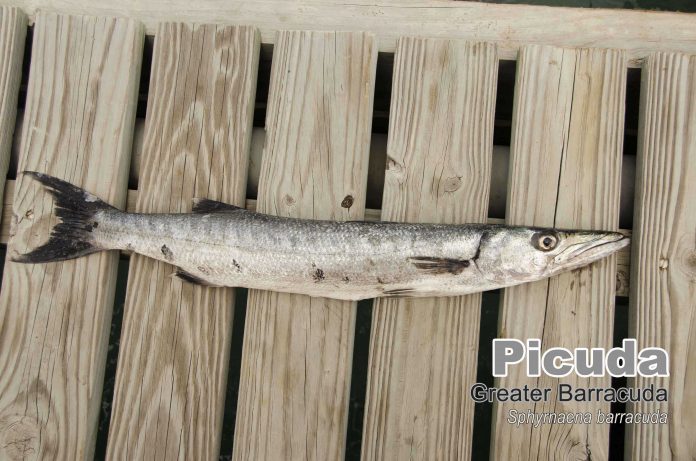(Oranjestad)—If you’re ever planning on snorkeling during your vacation on Aruba, you may spot fish that you can’t recognize. One of these may be the “Picuda”, a very common fish that swims all year long in the waters of Aruba. Here’s some information about the beloved Picuda.
Let’s talk about the names of fish. Do you know your fish? This is an informative article that illustrate some fish and their names in Papiamento, which the Department of Agriculture, Livestock and Fisheries, known as “Santa Rosa”, wants to share and also obtain information from the public.
Picuda, Sphyraena barracuda, Greater Barracuda
Well known is the Picuda on the island—Barracuda in English. Its scientific name is Sphyraena barracuda. It is a widely caught fish. It is found throughout the year in our waters, where it is a so-called “ambush predator” that stays still or floats in the water waiting for its prey to approach so it can attack it with lightning speed. It is well known for fishermen, especially for its white flesh in fish soup. In fishing culture, there are many other names, such as Pecho blanco, Blekito, Banana, or Bleki. The names vary according to size.
Description
The Picuda is a long fish, with a round body like a torpedo and silver in color with shiny black stripes. Below, that is, the belly, is whiter, while the top part is darker. Its snout is very pointed, and the lower jaw is longer than the upper one. Its peduncle, where the body meets the tail, is thick, while the tail also forms a crescent but in this case one more “full” than that of mullet or conefish. This reflects the hunting style of the Picuda. It needs to be able to accelerate quickly when the prey gets close.
In Aruba:
Picuda can be found in our waters around our island throughout the year. Picuda, in our waters, is edible without any problem. Picuda is also a highly sought-after fish by sports fishermen or recreational fishermen because it puts up a good fight once hooked. It can be caught via trolling from a boat, casting from shore with a line or rod, or by jigging, casting the lure (artificial bait) and moving it with certain rod motions.
Picture courtesy of the Department of Agriculture, Livestock and Fisheries.



















